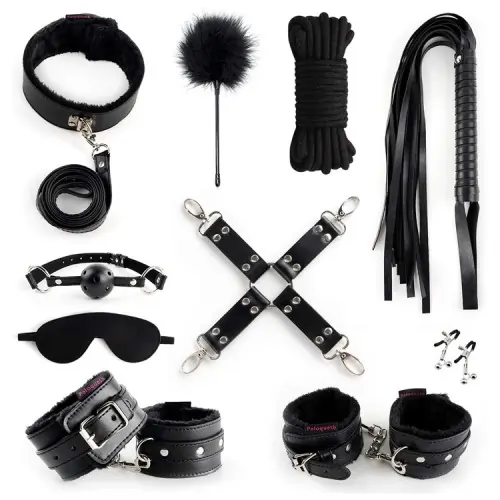Benefits of BDSM – Discover Pleasure & Trust

The Benefits of BDSM
What Does BDSM Stand For?
BDSM is an acronym that stands for Bondage and Discipline (B&D), Dominance and Submission (D/s), and Sadism and Masochism (S&M). It encompasses a wide variety of erotic practices, relationship dynamics, and roles. While it might look intimidating to newcomers, BDSM is far more about connection, consent, and trust than just pain or punishment.
Breaking the Myths Around BDSM
Let’s be real—BDSM often gets misunderstood. Movies and media might paint it as something extreme, dark, or even dangerous. But in reality, most BDSM activities are safe, sane, and consensual. At its core, it’s about creating a deep emotional and physical connection through trust and communication.
Is BDSM Just About Pain?
Absolutely not. While some people enjoy the thrill of pain (in safe amounts), many others practice BDSM in ways that don’t involve any pain at all. It could be about power exchange, role-playing, bondage, or sensory exploration. The goal? Heightened intimacy and pleasure.
Psychological Benefits of BDSM
Trust and Communication
BDSM thrives on communication. Before any scene, partners discuss boundaries, desires, and safe words. This kind of openness builds incredible trust—you’re literally handing over control or taking it with care. It’s the ultimate trust exercise in the bedroom.
Emotional Intimacy
Sharing vulnerabilities, exploring fantasies, and pushing comfort zones (safely) leads to deeper emotional intimacy. Whether you’re the dominant or submissive, you’re connecting on a raw, honest level that goes beyond surface attraction.
Stress Relief and Mental Clarity
Ever feel like your mind won’t shut off? BDSM can offer a mental escape. Submissives often describe scenes as a chance to “let go,” where the mental load disappears. The dominant, on the other hand, gains clarity through focus and responsibility. It’s a therapeutic release for many.
Boosting Self-Awareness and Confidence
Knowing what you like—and don’t like—makes you more confident in and out of the bedroom. BDSM encourages exploration and self-awareness, helping people better understand their bodies and desires. It’s empowering, to say the least.
Physical Benefits of BDSM
Endorphin and Dopamine Release
During BDSM play, especially scenes involving sensory stimulation or mild pain, the brain releases endorphins and dopamine—natural feel-good chemicals. This can result in a “subspace” (a blissful, meditative state for subs) or “topspace” (a hyper-focused flow state for doms).
Safe Physical Exploration
With proper tools, planning, and consent, BDSM allows for safe experimentation. Whether it’s restraints, spanking, temperature play, or sensation exploration, you’re getting to know your body in new and exciting ways—all within a safety net of pre-discussed boundaries.
Enhancing Sexual Pleasure and Sensations
Many BDSM activities are designed to heighten sensation and anticipation. Blindfolds, feather ticklers, wax play—these tools make every touch electric. By focusing on sensation and delay, BDSM can make orgasms more intense and pleasure more layered.
Relationship Benefits of BDSM
Strengthening Bonds Through Role Play
Trying new roles like teacher/student or boss/employee isn’t just spicy—it’s a bond-strengthening experience. Couples often find that role-playing helps them explore fantasies together while laughing, learning, and loving more deeply.
Deepening Intimacy and Understanding
BDSM involves continual communication, checking in, and aftercare. These moments of care and debriefing strengthen emotional intimacy and help both partners feel seen, valued, and secure.
Exploring Boundaries Together
Trying BDSM isn’t just about “doing stuff to each other”—it’s about exploring limits and expanding comfort zones together. This shared experience builds empathy, understanding, and confidence in the relationship.
BDSM and Consent
The Role of Consent in BDSM
Consent is not just important in BDSM—it’s the foundation. Every scene begins with clear, informed, enthusiastic agreement. That means nothing is done without discussion and approval. It’s about respect at every level.
Safe Words and Aftercare
Safe words like “red” or “yellow” give anyone in the scene the power to pause or stop play immediately. Aftercare—snuggling, talking, drinking water—helps bring both partners back to emotional balance. It’s not optional; it’s essential.
Creating a Judgment-Free Zone
BDSM encourages people to share their desires without shame. It’s about embracing kink and curiosity, and saying, “Hey, I trust you enough to show this side of me.” That’s powerful.
BDSM as a Lifestyle or Occasional Practice
Is BDSM for Everyone?
Not necessarily—and that’s okay. Some people find BDSM fits their personality or enhances their relationship, while others may not enjoy it. The beauty is in knowing there’s no right or wrong way to be sexual, as long as it’s consensual.
Occasional vs. Lifestyle Choices
Some folks play occasionally, some live the BDSM lifestyle 24/7 with full-time dynamics. What matters most is what works for you and your partner(s). Start small, talk often, and build from there.
How to Start Exploring BDSM Safely
Begin with research, honest conversations, and consent. Try reading, attending workshops, or experimenting with light bondage or sensory play. The key is to take things slow and always prioritize safety and communication.
Conclusion
BDSM isn’t just about kink—it’s about connection, communication, and deep exploration. From psychological release to physical pleasure, the benefits of BDSM are vast and personal. Whether you’re curious or experienced, BDSM offers a world of trust, growth, and intimacy that can transform your relationships and understanding of self.
FAQs
1. Is BDSM dangerous?
Not when practiced safely. Communication, consent, and using proper techniques and tools make BDSM safe and enjoyable for all parties involved.
2. Can BDSM help my relationship?
Absolutely! It promotes communication, trust, and exploration, which can bring couples closer and reignite intimacy.
3. Do I need special gear to try BDSM?
Nope. You can start with simple items like scarves, blindfolds, or just verbal role play. Fancy gear is fun but not essential.
4. How do I talk to my partner about BDSM?
Start with curiosity, not pressure. Say something like, “I read about BDSM and thought it sounded interesting. Would you be open to exploring it together?”
5. Is BDSM only for people with specific kinks?
Not at all. BDSM is broad and flexible. You can explore dominance, submission, sensation play, and more—with or without kinky preferences.
Please don’t forget to leave a review.


